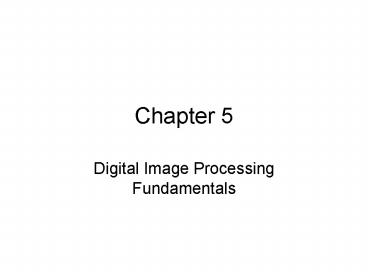Digital Image Processing Fundamentals - PowerPoint PPT Presentation
1 / 63
Title:
Digital Image Processing Fundamentals
Description:
Trading an eye for an ear. An eye is a Multi-mega pixel camera. It ... Median Octagon, less aggressive. Median Octagon results. Median Filtering is not FREE! ... – PowerPoint PPT presentation
Number of Views:81
Avg rating:3.0/5.0
Title: Digital Image Processing Fundamentals
1
Chapter 5
- Digital Image Processing Fundamentals
2
Learning Goals
- The human visual system
- Digitizing images
- Display of Images
3
Trading an eye for an ear
4
An eye is a Multi-mega pixel camera
- It has a lens (adjustable zoom)
- It has an automatic f-stop (iris 2-8 mm)
- It has a sensor plane (100 million pixels)
- The sensor has a transfer function senstive to
mesopic range 380 to about 700 nm
5
The eyes have a USB2 data rate!
- 250,000 neurons in the optic nerve
- variable voltage output on EACH nerve
- 17.5 million neural samples per second
- 12.8 bits per sample
- 224 Mbps, per eye (a 1/2 G bps system!).
- Compression using lateral inhibition between the
retinal neurons
6
Response curves
- Eye has Gaussian response to light.
- Gives rise to biologically motivated image
processing
7
Quantization of an Image
- Computers use digital cameras -gt quantization
8
Delta-function
9
Sampling an Image
10
Samplingconvolution w pulse train
11
Quantization Error is visible
12
Displays
- Color Monitors are made for people
13
Chapter 6-7
- Opening and Saving Images
14
Chapter 8 Convolutionwith a kernel, g(x)
15
Convolution
- 1D and 2D signal processing
16
Consider the delta function
17
Time-shift delta
18
Sample the input (its a convolution!)
19
What does sampling do to spectrum?
20
What is the spectrum?
21
Fourier Coefficients
22
CTFT
23
Eulers identity
24
Sine-cos Rep
25
Harmonic Analysis
26
Convolutiontime-shiftmulti
27
Convolution Thm
multiplication in the time domain convolution
in the frequency domain
28
Sample
29
Spectrum reproduced
spectrum to be reproduced at intervals
30
Summary
31
Example of 1D convoln
32
2D Convolution
33
Region of Support
- The region of support is defined as that area of
the .kernel which is non-zero - linear convolutionsignal has infinite extent
but kernel has finite support - If function has finite region of support we have
compact support
34
Real images have finite region of support
- But we treat them as periodic and infinite!
- We repeat kernels so that they have the same
period as the images. - We call this cyclic convolution.
35
Convolution in 2D
36
Avoid the Mod op
37
What is wrong with avoiding the mod op?
- How do I find the center of the kernel?
38
Cyclic Convolution
39
Implementing Convolution
for(int y 0 y lt height y) for(int
x 0 x lt width x) sum 0.0
for(int v -vc v lt vc v)
for(int u -uc u lt uc u)
sum fcx(x-u) cy(y-v) k uucvvc
if (sum lt 0) sum 0 if (sum gt 255)
sum 255 hxy (short)sum
40
What happens to the image if you ignore the wrap?
41
Cyclic Convolution keeps the edges
42
Can you think of a better way to implement
convolution?
- Keep the edges!
- Dont use the mod operation.
- How about growing the image by the size of the
kernel2?
43
Convolution is slow, how can I speed it up?
- JAI!
- FFT!?
- Other ideas?
44
Chapter 9
- Spatial Filters
- Blurring
- Median Filtering
- Hi-pass filtering
- SpatialFilterFrame and JAI
45
BlurringLow-pass Filters
46
Why Blur an Image?
- Remove Noise
- Other ideas?
47
Averagelow-pass
48
Want Unity Gain
49
Many variations on LP filters
50
Gaussian Blur
51
Why use Gaussian Blur?
- How the eye works
- Symmetric
- Differentiable
- Smooth
52
Classic bell curve
53
Larger Kernelsmore blur
54
Median Filtering
- Middle of a list of samples listed in ascending
order. - Sort samples, return n/2
55
Why use median filtering?
- Discard outliers
- 0, 85, 90, 87 and 100. The mean is 72
- Median is 87.
- 0, 85, 87, 90, and 10087
56
How do I implement the median?
57
Salt and Pepper
58
Median 3x3
59
Median on any kernel
60
Median result
61
Median Octagon, less aggressive
62
Median Octagon results
63
Median Filtering is not FREE!
- Image degradation
- Selective median filtering.
- How do you know when to apply it?































